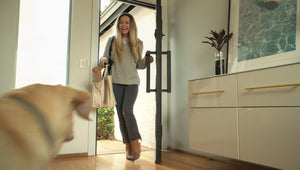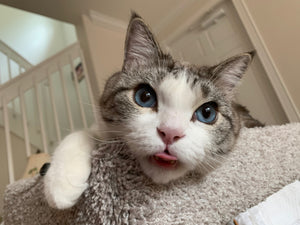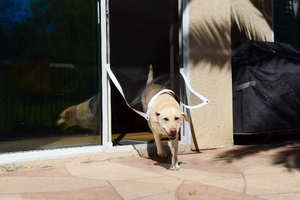Heatstroke in Dogs and Cats: Awareness & Prevention
During the hot summer months, it is especially important to be aware of the signs of heat stroke in dogs and cats. Cat and dog heatstroke can commonly occur when they are overexposed to sunlight and heat and become unable to regulate their natural body temperature.
Understanding the symptoms of heatstroke in dogs can help prevent dangerous situations when dogs get too hot. Dogs and cats regulate their body temperature through respiration (when they pant) and don’t have sweat glands as humans do. Therefore, when they cannot release heat quickly enough and lower their body's high temperature, heatstroke can quickly occur.
Being aware of the signs of dehydration in dogs is crucial to avoid potentially life-threatening situations. Heatstroke can be a very serious situation, so it’s important to know the symptoms and solutions for how to deal with heat exhaustion in dogs and cats.
Quick Tip: You can use Pedialyte for dogs if you see signs of dog dehydration, overheating, or heatstroke. Pedialite for dogs should only be used if you see warning signs of extreme dehydration such as excessive panting and vomiting (try mixing one part Pedialyte, one part water in a bottle and feeding on the way to the vet). Avoid the flavored options which have coloring agents that many dogs are allergic to.
Who is at risk?
Any dog or cat can be susceptible to heatstroke. Common causes that can cause heatstroke are if they are exposed to extreme sunlight, heat, or confined in a hot area, such as a hot car or parked car, for an extended period of time. We advise that owners with pet doors pay careful attention to their canine and feline companions wandering outside during the summer months.
Pets with prevailing medical conditions could also be at a higher risk for other problems such as issues with heart rate, organ damage, or maybe organ failure when body heat and blood pressure are not regulated.
Dogs with dog doors have more freedom outdoors and may be at an increased risk for heatstroke or heat stress (and dog doors are versatile too; you can even get a sliding glass door with dog door mount installed). Be sure to lock your pet door if you do not want your dog or cat to go outside during certain hours when it is really hot!
Be careful not to leave your dog unattended during hot summer months, and always have a cool area for your pup to take breaks and for the dog's temperature to stay cool during outside adventures. Check out this chart below for reference:
Heatstroke Symptoms:
If a dog is suffering from heatstroke, you may observe one or more of the following symptoms: hyperventilation, excessive panting, dry and pale gums, rapid pulse, increased salivation or excessive drooling, difficulty breathing, inability to focus or confused appearance, and even vomiting or seizures.
What To Do If Your Dog Experiences Heatstroke on Hot Days:
- Quick Response. The best thing a pet owner can do in the case of heatstroke is to respond quickly. Constantly observe your dog and your dog's body temperature in hotter environments for prevention purposes.
-
Relocate. Quickly relocate your dog to the shade or a cooler environment with air conditioning.
 ent.
ent. - Cool Water. Apply cool (not freezing cold!!) water to touchpoints on your dog’s body. Focus on areas such as your dog’s stomach, inner thighs, and footpads. Don’t submerge your dog in water, or apply freezing cold water. Submerging your dog in water can cause shock, resulting in cardiac arrest or bloating from rapid cooling. Freezing cold water constricts blood vessels, and is counterproductive to the cooling process.
- Movement. Keep both your dog moving, as well as airflow. Keeping your dog moving helps to circulate blood. It is also important to keep your dog exposed to air so that proper evaporation can take place. Wetting your dog with cool water and then placing him in a kennel or covering him with a towel will prevent evaporation, hindering their ability to return to normal body temperature regulation.
- Hydration. Provide your dog with small amounts of water. You don’t want your dog to drink too rapidly, but small amounts of cool water will be beneficial for hydration. Don’t give your dog other types of drinks such as human performance beverages.
- Call the Vet. Dog owners should call the vet as soon as possible. It is important to relocate your dog quickly to cool ground, but it is also necessary to follow the advice of a professional based on your individual situation. Each dog will respond differently to various degrees of heatstroke, so be in contact with your vet immediately.
 Pet Doors Note on Cats: Those with outdoor cats or cats who frequently travel between cat doors, beware of heatstroke in your feline friends as well.
Pet Doors Note on Cats: Those with outdoor cats or cats who frequently travel between cat doors, beware of heatstroke in your feline friends as well.
Depending on your weather, allowing your cats outside access may be a great idea to cool off, or it may expose them to more extreme heat than your house.
Setting up an outdoor "catio" for your cat is a safe way to allow them some fresh air, and it keeps them close so you can monitor their health. If your cat is showing signs of heatstroke, move your cat to a cool area, and wet with cool water. Provide cool drinking water, and call your vet immediately if you suspect your cat is experiencing heatstroke.





My 11 year old dog usually has stayed inside however i left him outside 3 days ago to run 10 mins away from house when i got back home my dog acts like hes going blind he was laying in floor to storage room in his water bowl water covered his wet frail body. I took him to the vet and was told he thought he had a stroke but i do not know whats best to do with a stroke animal. He drinks water but refuses food i got some critical care food to feed him from buy he has to have me pull his food up in a big shringehe swallows he started to throw up this morning hes walking really shaky but he can walk now where before he wasnt i had to pack him. I now have to walk next to him with my hands under his belly so he dont fall anything i can to to elp him the best